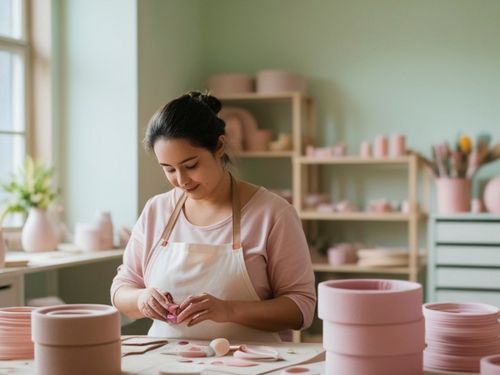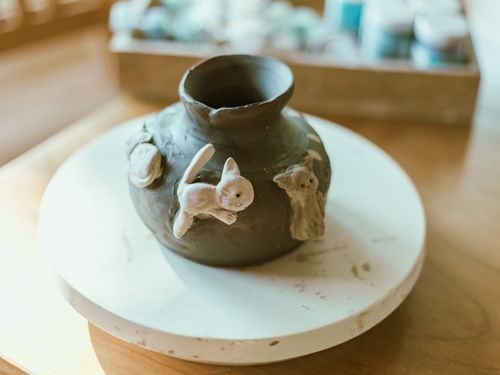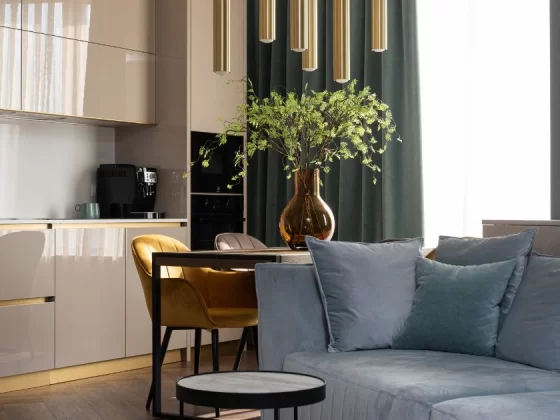Handmade ceramic pottery has been a part of human culture for thousands of years. From the simplest clay vessels to elaborate artistic creations, ceramics hold a unique place in both functional and decorative realms. In recent years, this ancient craft has made a resurgence in modern homes, where handmade pottery is celebrated not only for its beauty but also for its ability to bring warmth, texture, and personality to any space. Choosing handmade ceramic pottery for home décor is more than an aesthetic decision. It is a celebration of craftsmanship, sustainability, and individuality.
The Charm of Handmade Ceramics
One of the most compelling aspects of handmade ceramics is the human touch. Every piece is created with care, often on a potter’s wheel or by hand, resulting in subtle variations in shape, texture, and glaze. These imperfections are not flaws but rather marks of authenticity. Unlike mass-produced ceramics, which tend to be uniform and predictable, handmade pottery carries character and a story within each curve and finish. When displayed in a home, it adds warmth and a sense of connection to the maker, transforming a simple object into art.
Handmade ceramics also reflect cultural traditions and artistic influences from around the world. For instance, Japanese pottery often emphasizes simplicity, natural textures, and earthy glazes, creating a sense of calm and minimalism. In contrast, Moroccan ceramics frequently feature intricate geometric patterns and vibrant colors, making them eye-catching statement pieces. By incorporating these globally inspired designs into home décor, homeowners can create spaces that feel curated and layered with meaning.
Versatility in Home Décor
One of the reasons handmade pottery is so popular in interior design is its versatility. Ceramic pieces can serve both functional and decorative purposes, seamlessly blending into any room. Vases are the most common example, providing a vessel for fresh flowers, dried arrangements, or even branches for seasonal displays. Their forms can range from simple cylindrical shapes to dramatic sculptural designs, accommodating both minimalist and maximalist aesthetics.
Bowls and dishes are another functional yet decorative option. Handmade ceramic bowls can hold fruit on a kitchen counter, serve snacks during a gathering, or sit as a centerpiece on a dining table. Their glazes and textures often catch the light, adding visual interest even when empty. Similarly, ceramic plates, platters, and serving pieces elevate everyday meals into experiences, demonstrating that beauty and utility can coexist in a single object.
Beyond the kitchen, handmade ceramics can enhance living rooms, bedrooms, and outdoor spaces. Candle holders, planters, and decorative jars add layers of texture and color, complementing other materials such as wood, glass, and textiles. The tactile quality of ceramics invites touch and interaction, making a space feel more intimate and inviting. Unlike flat surfaces or metal décor, ceramics provide depth and dimensionality, enhancing the overall sensory experience of a room.
Sustainability and Ethical Appeal
Sustainability is an increasingly important consideration for homeowners, and handmade ceramics align perfectly with eco-conscious values. Unlike factory-made items, which rely on mass production, energy-intensive processes, and synthetic materials, handmade pottery is often created locally using natural clay and glazes. Many artisans prioritize environmentally friendly techniques, such as low-temperature firings and lead-free glazes, ensuring that their products are safe and sustainable.
Choosing handmade pottery also supports small businesses and individual artists. Every purchase helps preserve traditional craftsmanship and encourages the continuation of techniques refined over centuries. This ethical appeal adds an extra layer of meaning to décor choices, transforming simple objects into stories of human creativity and community support. By selecting handmade pieces, homeowners contribute to a cycle of sustainability and artistry rather than mass consumption.
Finding the Right Pieces for Your Home
Selecting handmade ceramic pottery for your home requires consideration of style, function, and scale. Start by thinking about the atmosphere you want to create in each room. For a serene, minimalistic bedroom, choose pieces with soft, muted tones and smooth textures. If your goal is a vibrant and eclectic living space, explore bold colors, geometric patterns, and asymmetrical forms. Handmade pottery is forgiving in style, adapting well to different interior themes, from Scandinavian and bohemian to rustic and contemporary.
Scale is another important factor. Large statement vases or oversized planters work well in open living areas or entryways. At the same time, smaller bowls, mugs, and jars can be grouped on shelves, side tables, or countertops to create visual interest. Consider the balance of colors and finishes throughout the space. Mixing matte and glossy glazes, muted earth tones with brighter accents, or textured surfaces with smooth ceramics can elevate a room’s design without overwhelming it.

When shopping for handmade pottery, pay attention to the story behind the pieces. Many artisans share information about their inspiration, techniques, and clay sources. This adds an emotional connection and helps you choose items that resonate with your personal aesthetic. Visiting local pottery studios, craft fairs, or online artisan marketplaces provides access to unique designs that are impossible to replicate in stores selling mass-produced home décor.
Integrating Handmade Ceramics into Different Rooms
Living Room
In living rooms, ceramics can serve as focal points or subtle accents. Large vases with tall floral arrangements can anchor a corner, while small decorative bowls or sculptural objects can be arranged on coffee tables or shelves. Planters in handmade pottery bring natural elements indoors, creating a calming, organic environment. When layered with other textures such as woven rugs, wooden furniture, and soft textiles, ceramics add depth and a handcrafted charm that makes the room feel inviting.
Kitchen and Dining Areas
The kitchen is another ideal space for handmade pottery. Bowls, mugs, plates, and serving dishes elevate everyday meals into thoughtful experiences. Imagine a breakfast scene with a handcrafted ceramic mug filled with coffee, alongside a small bowl of fresh fruit. Not only does this enhance the aesthetic, but it also encourages mindful, slow living. Statement platters and serving dishes during gatherings create conversation pieces, as guests often admire the craftsmanship and unique designs.
Bedroom
Bedrooms benefit from the serene, tactile quality of ceramics. Vases on nightstands can hold fresh flowers or branches, bringing life and natural fragrance to the room. Decorative jars can store jewelry or other small essentials, combining function with beauty. For those seeking a spa-like retreat, ceramics with soft glazes and neutral tones create a soothing environment that encourages relaxation and comfort.
Outdoor Spaces
Outdoor patios and gardens also welcome handmade ceramics. Planters with vibrant flowers or lush greenery create eye-catching focal points, while ceramic lanterns and candleholders enhance the evening ambiance. Outdoor ceramics must be carefully chosen for durability, especially in climates with extreme weather. Handmade pieces often withstand outdoor conditions better than mass-produced items because of the quality of materials and attention to craftsmanship.
The Beauty of Customization
One of the most appealing aspects of handmade ceramics is the potential for customization. Many artisans offer custom orders, allowing you to choose specific shapes, colors, glazes, or patterns. This personal touch ensures that each piece fits perfectly within your home’s décor and reflects your personality. Customized pottery also makes excellent gifts, adding thoughtfulness and uniqueness that mass-produced items cannot match.
For instance, a personalized vase with a favorite color palette or a custom set of ceramic mugs with engraved initials can become cherished keepsakes. Some artists even create pottery based on architectural sketches or photographs, turning everyday memories into lasting works of art. This versatility and adaptability make handmade ceramics not just décor items but also meaningful expressions of identity.
Caring for Handmade Ceramics
Handmade ceramics require care to maintain their beauty and longevity. While most pottery is functional, it is essential to follow the artist’s instructions regarding washing and handling. Many pieces are dishwasher-safe, but handwashing with mild soap is recommended to preserve glazes and prevent chipping. Avoid sudden temperature changes, as ceramics can crack if exposed to extreme heat or cold too quickly. With proper care, handmade pottery can last for generations, becoming family heirlooms and treasured possessions.
Displaying ceramics also requires thoughtfulness—position delicate pieces on stable surfaces, away from high-traffic areas, to prevent accidents. Grouping ceramics into clusters or arranging them alongside complementary objects, such as books, plants, or textiles, can create visually appealing vignettes. The goal is to integrate them naturally into your home while highlighting their artistry.
Trends in Handmade Ceramic Pottery
Modern handmade pottery has embraced trends without losing its traditional charm. Earth tones, organic shapes, and textured glazes are particularly popular, reflecting a desire for natural and sustainable design. Minimalist styles, inspired by Scandinavian and Japanese aesthetics, emphasize clean lines, muted colors, and functional beauty. At the same time, bold colors, metallic finishes, and asymmetrical forms cater to those seeking statement pieces that energize a space.

Another emerging trend is the combination of ceramics with other materials. Handmade pottery with wooden lids, metal accents, or integrated lighting creates multifunctional objects that are both practical and artistic. These hybrid designs appeal to homeowners who value utility alongside visual appeal, demonstrating that ceramics can evolve with contemporary design demands while retaining their handcrafted essence.
Why Handmade Pottery Elevates Home Décor
The appeal of handmade ceramic pottery goes beyond aesthetics. It represents a connection to culture, history, and human creativity. Each piece tells a story, whether through its form, texture, or glaze. By integrating handmade ceramics into a home, individuals are not just decorating a space but cultivating an environment that feels alive, warm, and authentic. These objects invite touch, interaction, and appreciation, encouraging mindfulness and attention to detail in daily life.
Furthermore, handmade pottery is timeless. While trends in furniture and textiles may change rapidly, ceramic pieces often retain their relevance and charm. A simple, well-crafted vase from decades ago can look equally stunning alongside modern furnishings. This longevity makes handmade ceramics a wise investment for anyone seeking enduring style and quality in their home décor.
Celebrating Artistry and Timeless Home Décor
Handmade ceramic pottery embodies artistry, tradition, and functionality. From vases and bowls to planters and decorative objects, these pieces bring warmth, texture, and individuality to every room. Their versatility allows them to blend seamlessly with different design styles, while their sustainability and ethical appeal reflect modern values. By choosing handmade pottery, homeowners not only enhance their spaces aesthetically but also support artisans and preserve centuries-old craftsmanship.
Incorporating handmade ceramics into your home is an invitation to slow down, appreciate artistry, and create meaningful environments. Whether displayed in the living room, kitchen, bedroom, or outdoor areas, these pieces elevate everyday life while connecting the present to centuries of tradition. Handmade ceramic pottery is more than décor. It is a celebration of human creativity and a lasting expression of beauty in its purest form.





